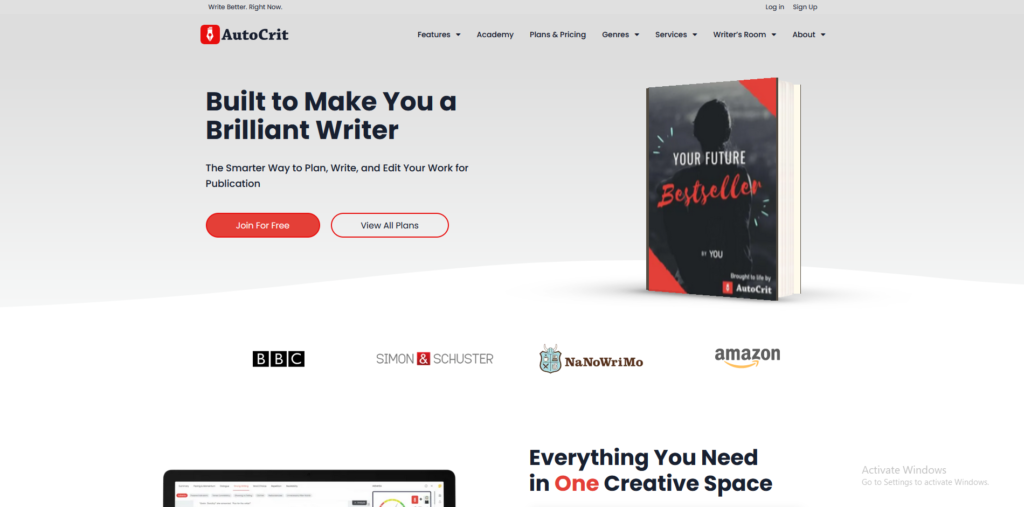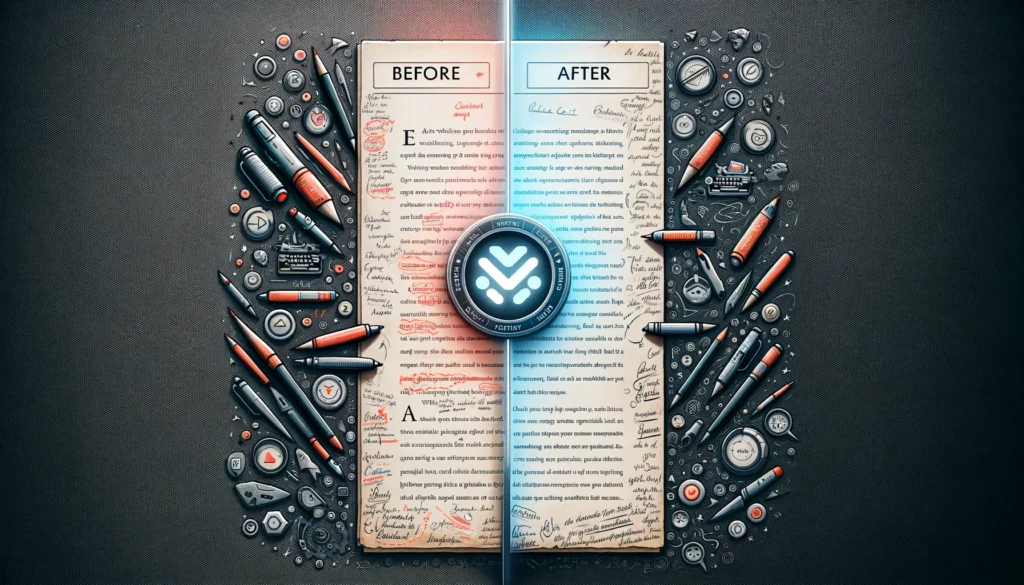Jumping into this AutoCrit review, I’ve decided to take a closer look at what this tool offers. It’s pitched as this digital sidekick for writers, aiming to sharpen your drafts and get your stories reader-ready.
I’ve given AutoCrit a thorough spin to really understand how it fits into the writing process. It’s not just about flagging what’s wrong; it’s about guiding improvements. This review isn’t swayed by hype; it’s based on what I’ve personally encountered while using the platform.
With AutoCrit, it’s all about digging into the nuts and bolts of your writing, from character dialogue to pacing. I wanted to see if it lives up to its promises or if it’s more like just another set of eyes on your work. So, let’s dive in and see what AutoCrit is all about.
AutoCrit Review

After spending some time with AutoCrit, I’ve got a bit more to share. This tool isn’t just about catching typos or fixing grammar. It’s like having a keen-eyed editor who’s obsessed with the details that make your writing stand out.
From pacing to dialogue, it scrutinizes your work to suggest improvements that could really elevate your story.
The user interface? It’s pretty slick. Uploading your document is straightforward—no hassle, no fuss. And once your text is in there, navigating through AutoCrit’s feedback is intuitive.
The platform highlights areas for improvement, such as overused words, sentence structure, and even the pacing of your narrative.
It’s designed so you can quickly understand what needs work, which I appreciate. You don’t need to be tech-savvy to get the hang of it.
But here’s the real kicker: AutoCrit doesn’t just throw suggestions at you. It explains why changing something might make your writing stronger.
This isn’t about following rules blindly; it’s about understanding how those tweaks can impact your reader’s experience.
And that, for me, has been incredibly valuable. It’s one thing to know that a sentence is awkward, it’s another to understand how making it smoother can pull your reader deeper into the story.
AutoCrit is more than just a tool; it’s a learning experience. It’s great for anyone serious about their writing and willing to put in the work to make it better. Sure, it’s not going to replace a human editor, but it’s a pretty solid stepping stone towards cleaner, more engaging writing.
How AutoCrit Works

Polishing your writing with AutoCrit starts by bringing your document into the platform, much like inviting an editor over to peek at your draft.
You log in, find where to upload or paste your text, and it’s like handing over your manuscript without the anxiety of a real-life critique.
After your text is in AutoCrit’s digital hands, the real magic begins. You’re not just throwing your work into a void; you’re given choices about what kind of feedback you’re hunting for.
Maybe your dialogue feels clunky, or perhaps your narrative pacing is more a crawl than a sprint. AutoCrit lets you pinpoint these concerns, offering analysis rather than a blanket check.
AutoCrit’s feedback feels less like wading through a swamp of corrections and more like following a breadcrumb trail of improvement. It doesn’t just highlight the “what” but dives into the “why” and “how” of making your writing shine.
Say it notices your dialogue could use a lift; it won’t just flag it but might suggest ways to give your characters more distinct voices.
And it’s not just about catching the small stuff. AutoCrit takes a look at your work’s bigger picture—pacing, narrative flow, character development—offering a variety of feedback that touches on nearly every aspect of your writing.
From the mechanical nuts and bolts to the artistry of your storytelling, it covers the gamut, providing a well-rounded view of where your draft stands.
What stands out is AutoCrit’s approach to feedback. It’s more collaborative than critical, guiding you through revisions like a mentor.
This platform isn’t about handing down judgments from on high; it’s about walking you through the process of refinement, helping you see not just where changes could be made, but how making them enhances your overall narrative.
It’s this partnership in the editing process that makes AutoCrit a standout tool for writers looking to bring out the best in their work.
Key Features of AutoCrit

First off, AutoCrit gives you feedback that actually fits what you’re writing. Say you’re working on a sci-fi story; it’ll check your work against what’s expected in sci-fi, not romance or mystery.
This means you’re getting advice that’s really meant for your type of story.
Then there’s the bit about choosing the right words. AutoCrit doesn’t just tell you when you’re repeating words too much; it helps you find better options.
This can make your writing feel more alive and less like you’re stuck using the same old phrases.
One of the coolest parts is how it checks your story’s pace. No one likes a story that drags or rushes too much, and AutoCrit points out where you might be slowing down or speeding up too much.
Plus, it gives tips on making your conversations between characters sound more real, which can be super helpful.
But how does it stack up against other writing tools? Well, lots of them do grammar checks and spell checks, but AutoCrit goes beyond that, focusing on your story’s flow, the strength of your dialogue, and even the rhythm of your writing.
AutoCrit helps with identifying and reducing repetition not just of words, but of phrase structures, too. This can be a game-changer because it makes your writing tighter and keeps readers engaged.
It’s one thing to know you shouldn’t repeat the same word too often, but catching similar sentence starts or structures? That’s next-level editing.
Another area where AutoCrit really helps is with emotional tells. This is about showing rather than telling in your writing. AutoCrit can point out where you might be directly naming emotions instead of describing them through action or dialogue, helping your writing feel more vivid.
Comparison-wise, while other tools focus a lot on grammar and spelling, which is super important, don’t get me wrong, AutoCrit dives into the nitty-gritty of storytelling elements.
It’s about enriching your narrative, character development, and ensuring your writing engages the reader from start to finish.
In terms of pricing and value, it really boils down to how much you’re aiming to get out of it. If writing is more than just a hobby for you, investing in a tool like AutoCrit could pay off in the quality of your work and, ultimately, in your writing career.
Benefits of Using AutoCrit
The biggest win with AutoCrit is that it actually helps you get better over time. It’s not just about fixing one story; it’s about learning what makes good writing, well, good.
By seeing what tweaks to make, you start noticing these things on your own, which is pretty awesome for any writer wanting to grow.
And if you’re dreaming of getting published, AutoCrit can be a big help in getting your manuscript ready.
It’s like prepping for a marathon; AutoCrit gets your writing in shape, ready to impress publishers.
I’ve heard from folks who’ve used AutoCrit that it’s made a real difference for them. They’ve gone from getting polite rejections to actually getting their foot in the door with publishers, which is pretty huge.
About its benefits, beyond just improving individual manuscripts, using AutoCrit regularly can help you internalize good writing habits. It’s about becoming more self-aware and critical of your work, which is invaluable. And for those aiming to get published, presenting a polished manuscript can make a significant difference in catching an editor’s or agent’s eye.
Limitations and Considerations
It’s not all perfect, though. Sometimes AutoCrit might not get the context or your creative style, which can be a bit frustrating.
And when it comes to pricing, you’ve got options, but you’ll want to weigh if it’s worth it for you. They’ve got different plans, so it’s about finding one that fits your budget and how much you’re going to use it.
As for limitations, it’s important to remember that AutoCrit, like any tool, isn’t perfect. Its suggestions are based on algorithms, which means sometimes your unique voice might clash with its recommendations.
It’s crucial to use AutoCrit as a guide rather than the final word on your writing.
AutoCrit vs. Other Writing Tools
Now, let’s take a look at some AutoCrit alternatives and how they all compare.
AutoCrit vs. Grammarly

AutoCrit focuses deeply on the storytelling aspect, offering feedback on pacing, dialogue, and narrative structure, which is crucial for fiction and non-fiction writers aiming to refine their manuscripts for publication.
It’s tailored for those who want in-depth analysis beyond grammar and spelling.
Grammarly, on the other hand, excels in real-time grammar, punctuation, and style suggestions.
It’s versatile, serving not only writers but anyone looking to polish emails, reports, or any written content. Its user-friendly interface and immediate feedback make it popular for quick edits.
What Sets AutoCrit Apart
AutoCrit’s niche focus on narrative elements provides a layer of analysis that’s particularly valuable for authors, which Grammarly doesn’t delve into as deeply, but Grammarly works better for other aspects of writing and editing.
AutoCrit vs. ProWritingAid

ProWritingAid shares similarities with AutoCrit in that it offers extensive feedback on writing style, including readability, overused words, and sentence structure.
It stands out with its detailed reports and suggestions for improving overall writing quality, catering to both academic and creative writers.
What Sets AutoCrit Apart
AutoCrit’s genre-specific feedback can be a significant advantage for writers looking for tailored advice to suit the conventions and expectations of their particular genre, something ProWritingAid offers in a more generalized manner.
AutoCrit vs. Scrivener

Scrivener is fundamentally different from AutoCrit, designed primarily as a powerful writing studio that organizes and structures long documents like novels, research papers, and screenplays.
Its strength lies in its comprehensive set of writing tools that help in drafting, revising, and compiling large writing projects.
What Sets AutoCrit Apart
Unlike Scrivener, which is a writing and organization tool, AutoCrit specializes in the post-writing phase, focusing on polishing and refining the draft with its editing capabilities.
AutoCrit is for those who have their manuscript ready and are looking to refine it, while Scrivener is more about the creation and organization process.
In summary, choosing between these tools depends on your specific needs—whether you’re looking for a robust writing environment (Scrivener), immediate grammatical and stylistic corrections (Grammarly), comprehensive style and readability feedback (ProWritingAid), or in-depth manuscript analysis with a focus on storytelling (AutoCrit).
Each tool has its unique strengths, and writers might find using a combination of these tools best suits their workflow.
Who Should Use AutoCrit?

AutoCrit fits best with fiction writers. This platform is a hit if you’re deep into making stories—novels, shorts, or even plays—because it digs into what makes a narrative compelling.
It looks at your story’s flow, how real your dialogues sound, and if your characters feel alive, offering specific suggestions to improve.
For non-fiction folks, especially if your work tells a story, AutoCrit has something for you too. It can help make sure your facts weave into a narrative that keeps readers hooked.
But, if your writing is more about presenting research or academic findings, AutoCrit’s specialty in creative elements might not align perfectly with your needs.
Here’s a piece of advice: think about what you want from your writing. If polishing a manuscript with an eye on publishing is your goal, diving into AutoCrit could be a smart move.
It’s about using its feedback to not just edit but also learn—seeing where and how you can tighten your narrative or make your characters more vivid.
Remember, AutoCrit isn’t about changing your style; it’s about refining it. Use it as a tool to see where you can boost your storytelling, then decide which suggestions to take on board.
That way, you keep your writer’s voice and make your story stronger.
Conclusion
Wrapping up this AutoCrit review, it’s clear that AutoCrit stands out for fiction writers looking to elevate their manuscripts. With its focus on narrative improvements and genre-specific feedback, it’s a tool that can genuinely make a difference in your writing journey, honing your story to catch a reader’s eye or even a publisher’s.
For anyone serious about their writing, exploring what AutoCrit offers is a step towards realizing your story’s full potential. It’s not just about fixing errors; it’s about refining your craft and bringing your narrative to life in ways you might not have considered.

